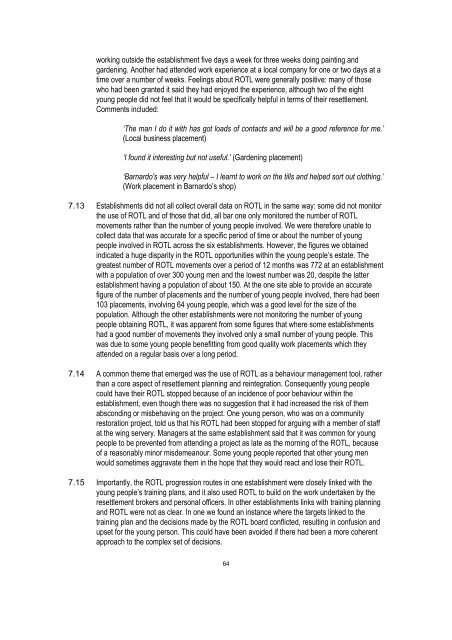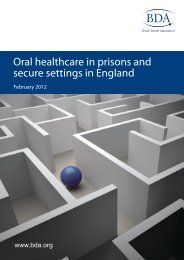Resettlement provision for children and young ... - Ministry of Justice
Resettlement provision for children and young ... - Ministry of Justice
Resettlement provision for children and young ... - Ministry of Justice
You also want an ePaper? Increase the reach of your titles
YUMPU automatically turns print PDFs into web optimized ePapers that Google loves.
working outside the establishment five days a week <strong>for</strong> three weeks doing painting <strong>and</strong><br />
gardening. Another had attended work experience at a local company <strong>for</strong> one or two days at a<br />
time over a number <strong>of</strong> weeks. Feelings about ROTL were generally positive: many <strong>of</strong> those<br />
who had been granted it said they had enjoyed the experience, although two <strong>of</strong> the eight<br />
<strong>young</strong> people did not feel that it would be specifically helpful in terms <strong>of</strong> their resettlement.<br />
Comments included:<br />
‘The man I do it with has got loads <strong>of</strong> contacts <strong>and</strong> will be a good reference <strong>for</strong> me.’<br />
(Local business placement)<br />
‘I found it interesting but not useful.’ (Gardening placement)<br />
‘Barnardo's was very helpful – I learnt to work on the tills <strong>and</strong> helped sort out clothing.’<br />
(Work placement in Barnardo’s shop)<br />
7.13 Establishments did not all collect overall data on ROTL in the same way: some did not monitor<br />
the use <strong>of</strong> ROTL <strong>and</strong> <strong>of</strong> those that did, all bar one only monitored the number <strong>of</strong> ROTL<br />
movements rather than the number <strong>of</strong> <strong>young</strong> people involved. We were there<strong>for</strong>e unable to<br />
collect data that was accurate <strong>for</strong> a specific period <strong>of</strong> time or about the number <strong>of</strong> <strong>young</strong><br />
people involved in ROTL across the six establishments. However, the figures we obtained<br />
indicated a huge disparity in the ROTL opportunities within the <strong>young</strong> people’s estate. The<br />
greatest number <strong>of</strong> ROTL movements over a period <strong>of</strong> 12 months was 772 at an establishment<br />
with a population <strong>of</strong> over 300 <strong>young</strong> men <strong>and</strong> the lowest number was 20, despite the latter<br />
establishment having a population <strong>of</strong> about 150. At the one site able to provide an accurate<br />
figure <strong>of</strong> the number <strong>of</strong> placements <strong>and</strong> the number <strong>of</strong> <strong>young</strong> people involved, there had been<br />
103 placements, involving 64 <strong>young</strong> people, which was a good level <strong>for</strong> the size <strong>of</strong> the<br />
population. Although the other establishments were not monitoring the number <strong>of</strong> <strong>young</strong><br />
people obtaining ROTL, it was apparent from some figures that where some establishments<br />
had a good number <strong>of</strong> movements they involved only a small number <strong>of</strong> <strong>young</strong> people. This<br />
was due to some <strong>young</strong> people benefitting from good quality work placements which they<br />
attended on a regular basis over a long period.<br />
7.14 A common theme that emerged was the use <strong>of</strong> ROTL as a behaviour management tool, rather<br />
than a core aspect <strong>of</strong> resettlement planning <strong>and</strong> reintegration. Consequently <strong>young</strong> people<br />
could have their ROTL stopped because <strong>of</strong> an incidence <strong>of</strong> poor behaviour within the<br />
establishment, even though there was no suggestion that it had increased the risk <strong>of</strong> them<br />
absconding or misbehaving on the project. One <strong>young</strong> person, who was on a community<br />
restoration project, told us that his ROTL had been stopped <strong>for</strong> arguing with a member <strong>of</strong> staff<br />
at the wing servery. Managers at the same establishment said that it was common <strong>for</strong> <strong>young</strong><br />
people to be prevented from attending a project as late as the morning <strong>of</strong> the ROTL, because<br />
<strong>of</strong> a reasonably minor misdemeanour. Some <strong>young</strong> people reported that other <strong>young</strong> men<br />
would sometimes aggravate them in the hope that they would react <strong>and</strong> lose their ROTL.<br />
7.15 Importantly, the ROTL progression routes in one establishment were closely linked with the<br />
<strong>young</strong> people’s training plans, <strong>and</strong> it also used ROTL to build on the work undertaken by the<br />
resettlement brokers <strong>and</strong> personal <strong>of</strong>ficers. In other establishments links with training planning<br />
<strong>and</strong> ROTL were not as clear. In one we found an instance where the targets linked to the<br />
training plan <strong>and</strong> the decisions made by the ROTL board conflicted, resulting in confusion <strong>and</strong><br />
upset <strong>for</strong> the <strong>young</strong> person. This could have been avoided if there had been a more coherent<br />
approach to the complex set <strong>of</strong> decisions.<br />
64

















